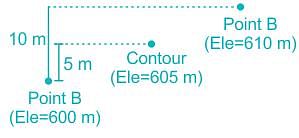Test: Contouring - Civil Engineering (CE) MCQ
10 Questions MCQ Test Geomatics Engineering (Surveying) - Test: Contouring
Which of the following type of levelling is necessary across a river ravine or any obstacle requiring a long site between two points?
According to the basic principles of contouring, which of the following is true?
| 1 Crore+ students have signed up on EduRev. Have you? Download the App |
Which of the following type of levelling is used when two points so situated that no place for the level can be found from which the lens of foresight and backsight will be even approximately equal?
For locating contours by indirect method, two guide points A (Elevation = 600 m) and B (Elevation = 610 m) are established. The horizontal distance between the two points on the plan is 1 cm. Find the distance of the contour of 605 m from point A (on the plan).
Which of the following error cannot be eliminated in reciprocal levelling?
Which of the following method is used for locating points on the ground by distance measurement and finding their elevations using a level.
When an instrument is at P the staff readings on P is 1.824 and on Q is 2.748. When the instrument at Q the staff readings on P is 0.928 and Q is 1.606. Distance between P and Q is 1010 mts. R.L. of P is 126.386. Find true R.L. of Q?
Under which of the following circumstances can the contour lines of different elevations intersect each other?
When instrument is at P the staff readings on P is 1.824 and on Q is 2.748. When instrument at Q the staff readings on P is 0.928 and Q is 1.606. Distance between P and Q is 1010 mts. R.L. of P is 126.386. Find combined correction for curvature and refraction?
|
19 videos|31 docs|35 tests
|
|
19 videos|31 docs|35 tests
|


















